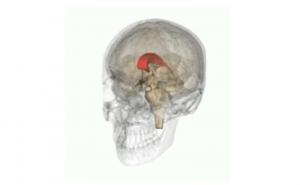What is oxytocin and what functions does this hormone perform?
The oxytocin is one of those substances that make the field of study of the neurosciences and biology.
The reason is that oxytocin is closely related to emotional ties of all kinds, both those that are as strong as those experienced by couples of lovers as the most diffuse, such as those that unite a person with her community of friends and neighbours.
Oxytocin is, therefore, a small piece of body chemistry that allows us to scientifically explain sensations as intense and inexplicable as those that have to do with the love. This is what makes many people try to understand its operation to get an idea about which is the nature of what they feel when they see a certain person, when they hug someone, or when they kiss.
What is oxytocin?
But let's start with the basics. What is oxytocin? It is basically a substance produced by our own body, specifically, in a structure of the brain called the hypothalamus and in other organs throughout the body. In terms of its function, oxytocin is tremendously versatile, and it can act as both a hormone and a neurotransmitter.
As a hormone, travels through the blood to reach different tissues and organs of the human body and cause them to react in a certain way, following protocols designed by thousands of years of evolution and that have to do with our way of adjusting to different situations in the best possible way.
As a neurotransmitter, oxytocin travels between the small spaces in which communication between neurons is established (the so-called synaptic spaces) and therefore has a role in the transmission of electrical signals throughout the nervous system, including the brain.
Functions of this hormone
However, one of its most significant concrete functions has to do with love and affection. Oxytocin participates in this aspect of our life as a hormone and also as a neurotransmitter.
1. Linked to love
It is frequently said that oxytocin is the substance responsible for the existence of love. This is still a reductionist and somewhat risky conclusion, taking into account that there is no single conception about what It is love and, in any case, many other factors intervene in the subjective experience related to affection and falling in love. substances. Oxytocin, as with all neurotransmitters, never works alone: it is always embedded in a biochemical puzzle that shapes our mind and our actions.
However, it is true that there are some patterns in which the relationship between oxytocin and all that set of experiences and processes that have to do with love and affection can be seen.
For example, oxytocin levels rise when familiar faces need to be recognized. They also increase when looking into the eyes of loved ones, it has a role in remembering members of your own group and, in general, is segregated in relatively large numbers in situations related to love and attachment. When we experience the sensation of sharing an intimate relationship with another person and when we feel that we are in an environment of trust, more oxytocin is secreted, as explained in the article on the chemistry of love.
In fact, It has been seen than in people with chronic depression Those given an extra dose of oxytocin tend to pay more attention to happy faces than to sad ones.
2. Regulating childbirth and maternity
Oxytocin is involved in other more varied processes. Etymologically, the word "oxytocin" means "rapid birth" in Greek. This is so because, as a hormone, oxytocin plays a very important role in childbirth and, by extension, in breastfeeding, two fundamental processes in motherhood, as verified by the physiologist Henry Dale, who gave this substance a name.
Specifically, oxytocin causes certain muscle fibers in the uterus to contract during labor, and it is also responsible for contractions to occur before birth. In addition, oxytocin has certain mechanical effects on the breasts, causing them to eject breast milk.
3. The role of this hormone in sexuality
During sex, oxytocin levels in the blood are usually significantly higher than normal.. This reinforces the hypothesis that this hormone has an important role in the chemical and mechanical processes involved in sexuality.
For example, it has been proven that oxytocin is involved in the appearance of vaginal contractions that make it easier for sperm to reach the egg. In men, it produces contractions in the prostate and seminal vesicles. Also, in both men and women blood oxytocin levels peak during orgasm.
4. Creating social ties
As we have seen, oxytocin is strongly associated with bonding, and not only those related to motherhood.
This is no accident. The fact of being able to count on the help and support of other people is one of the great evolutionary advantages that our species has had, and that is why it can be said that oxytocin is part of that social glue that has benefited us so much. If the fact of coming into contact with a person makes us secrete more oxytocin, in the long run we enter into a chemical and relational dynamic in which personal ties are very strong. In this way, the bond becomes very resistant and remains over time.
Bibliographic references:
- Delgado, J. M. (1998). Neuroscience Manual. Editorial Synthesis.
- Puelles, L. (2008). Neuroanatomy. Editorial Médica Panamericana.



